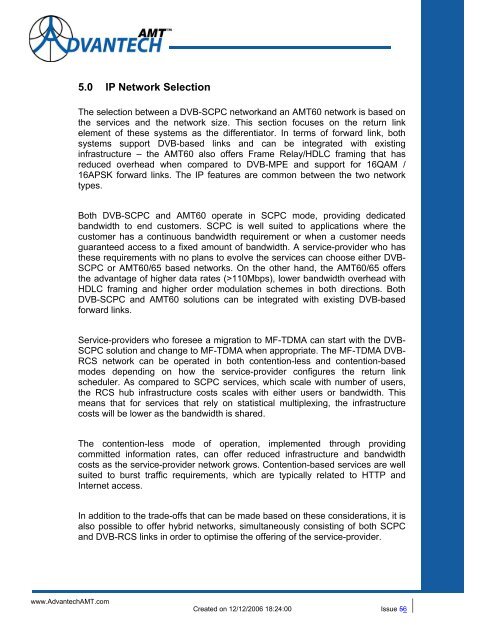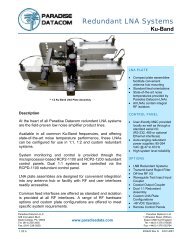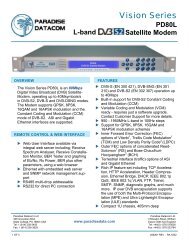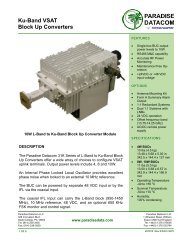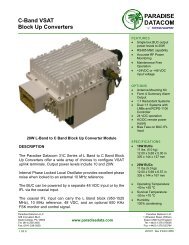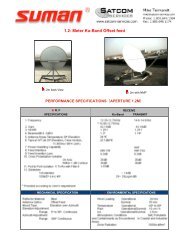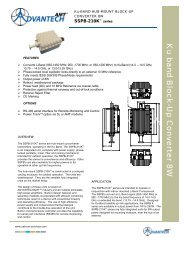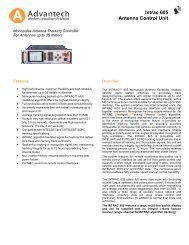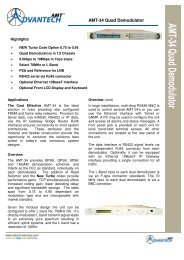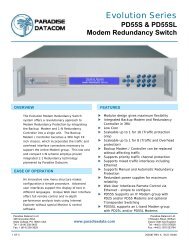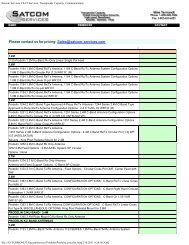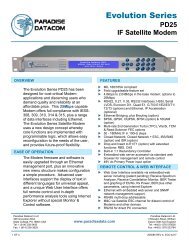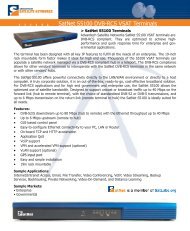Solutions for Satellite IP Data Transmission - Satcom Services
Solutions for Satellite IP Data Transmission - Satcom Services
Solutions for Satellite IP Data Transmission - Satcom Services
You also want an ePaper? Increase the reach of your titles
YUMPU automatically turns print PDFs into web optimized ePapers that Google loves.
5.0 <strong>IP</strong> Network Selection<br />
The selection between a DVB-SCPC networkand an AMT60 network is based on<br />
the services and the network size. This section focuses on the return link<br />
element of these systems as the differentiator. In terms of <strong>for</strong>ward link, both<br />
systems support DVB-based links and can be integrated with existing<br />
infrastructure – the AMT60 also offers Frame Relay/HDLC framing that has<br />
reduced overhead when compared to DVB-MPE and support <strong>for</strong> 16QAM /<br />
16APSK <strong>for</strong>ward links. The <strong>IP</strong> features are common between the two network<br />
types.<br />
Both DVB-SCPC and AMT60 operate in SCPC mode, providing dedicated<br />
bandwidth to end customers. SCPC is well suited to applications where the<br />
customer has a continuous bandwidth requirement or when a customer needs<br />
guaranteed access to a fixed amount of bandwidth. A service-provider who has<br />
these requirements with no plans to evolve the services can choose either DVB-<br />
SCPC or AMT60/65 based networks. On the other hand, the AMT60/65 offers<br />
the advantage of higher data rates (>110Mbps), lower bandwidth overhead with<br />
HDLC framing and higher order modulation schemes in both directions. Both<br />
DVB-SCPC and AMT60 solutions can be integrated with existing DVB-based<br />
<strong>for</strong>ward links.<br />
Service-providers who <strong>for</strong>esee a migration to MF-TDMA can start with the DVB-<br />
SCPC solution and change to MF-TDMA when appropriate. The MF-TDMA DVB-<br />
RCS network can be operated in both contention-less and contention-based<br />
modes depending on how the service-provider configures the return link<br />
scheduler. As compared to SCPC services, which scale with number of users,<br />
the RCS hub infrastructure costs scales with either users or bandwidth. This<br />
means that <strong>for</strong> services that rely on statistical multiplexing, the infrastructure<br />
costs will be lower as the bandwidth is shared.<br />
The contention-less mode of operation, implemented through providing<br />
committed in<strong>for</strong>mation rates, can offer reduced infrastructure and bandwidth<br />
costs as the service-provider network grows. Contention-based services are well<br />
suited to burst traffic requirements, which are typically related to HTTP and<br />
Internet access.<br />
In addition to the trade-offs that can be made based on these considerations, it is<br />
also possible to offer hybrid networks, simultaneously consisting of both SCPC<br />
and DVB-RCS links in order to optimise the offering of the service-provider.<br />
www.satcom-services.com<br />
Created on 12/12/2006 18:24:00 Issue 56


